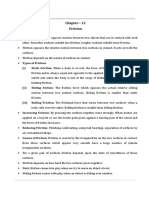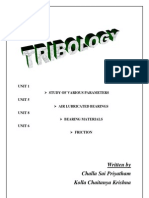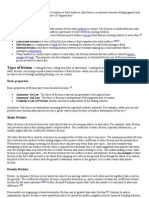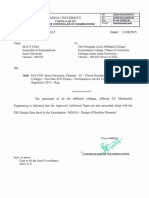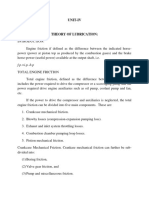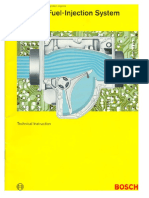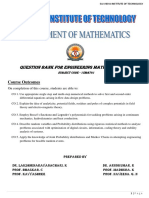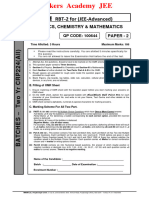0 ratings0% found this document useful (0 votes)
104 views10.2 Types of Friction
This document discusses different types of friction:
1. Static friction occurs when a body is at rest, while dynamic or kinetic friction is less than static friction and occurs when a body is in motion. Dynamic friction can be sliding, rolling, or pivot friction.
2. Friction is also classified as occurring between unlubricated surfaces, which is known as dry or solid friction, or between lubricated surfaces.
3. When surfaces are lubricated, the friction is either boundary friction with a very thin lubricant film, or fluid friction with a thick lubricant layer where the surfaces do not touch. Boundary friction follows solid friction laws while fluid friction depends on lubricant viscosity.
Uploaded by
rajmehaCopyright
© © All Rights Reserved
Available Formats
Download as DOCX, PDF, TXT or read online on Scribd
0 ratings0% found this document useful (0 votes)
104 views10.2 Types of Friction
This document discusses different types of friction:
1. Static friction occurs when a body is at rest, while dynamic or kinetic friction is less than static friction and occurs when a body is in motion. Dynamic friction can be sliding, rolling, or pivot friction.
2. Friction is also classified as occurring between unlubricated surfaces, which is known as dry or solid friction, or between lubricated surfaces.
3. When surfaces are lubricated, the friction is either boundary friction with a very thin lubricant film, or fluid friction with a thick lubricant layer where the surfaces do not touch. Boundary friction follows solid friction laws while fluid friction depends on lubricant viscosity.
Uploaded by
rajmehaCopyright
© © All Rights Reserved
Available Formats
Download as DOCX, PDF, TXT or read online on Scribd
You are on page 1/ 2
10.
2 Types of Friction
In general, the friction is of the following two types:
1. Static friction. It is the friction, experienced by a body, when at test.
2. Dynamic friction. It is the friction, experienced by a body, when in motion. The dynamic
fricytion is also called kinetic friction and is less than the static friction. It is of the
following three types:
a) Sliding friction. It is the friction, experienced by a body, when it slides over
another body,
b) Rolling friction. It is the friction, experienced between the surface which has balls
or rollers interposed between them.
c) Pivot friction. It is the friction, experienced by a body, due to the motion of
rotation as in case of foot step bearings.
The friction may further be classified as:
1. Friction between unlubricated surface, and 2. Friction between lubricated surfaces.
These are discussed in the following articles.
10.3 Friction Between Unlubricated Surfaces
The friction experienced between two dry and unlubricated surfaces in contact is
known as dry or solid friction. It is due to the surface roughness. The dry or solid friction
includes the sliding friction and rolling friction as discussed above.
10.4 Friction Between Lubricated Surfaces
When lubricant (i.e. oil or grease) is applied between two surface in contact, then
the friction may be classified into the following two types depending upon the thickness
of layer of a lubricant.
1. Boundary friction (or greasy friction or non-viscous friction). It is the friction,
expereienced between the rubbing surfaces, when the surfaces have a very thin
layer of lubricant. The thickness of this very thin layer is of the molecualr
dimension. In this type of friction, a thin layer of lubricant forms a bond between
the two rubbing surfaces. The lubricant is absorbed on the surfaces and forms a
thin film. This thin film of the lubricnat results in less friction between them. The
boundary friction follows the laws of solid friction.
2. Fluid friction (or film friction or viscous friction). It is the friction, experienced
between the rubbing surfaces, whrn the surfaces have a thick layer of the
lubricant. In this case, the actual surfaces do not come in contact and thus do not
rub against each other. It is thus obvious that fluid friction is not due to the
surfaces in contact but it is due to the viscosity and oiliness of the lubricant.
Note: The viscosity is a measure of the resistance offered to the sliding one layer
of the lubricant over an adjacent layer. The absolute viscosity of a lubricant may
be defined as the force required to cause a plate of unit area to slide
You might also like
- PHYS 1065 Lab 3 Pressure, Volume, and Temperature0% (1)PHYS 1065 Lab 3 Pressure, Volume, and Temperature12 pages
- Friction Laws of Dry Friction-Pivot and CollarNo ratings yetFriction Laws of Dry Friction-Pivot and Collar25 pages
- Unit 3 - Chemistry - WWW - Rgpvnotes.inNo ratings yetUnit 3 - Chemistry - WWW - Rgpvnotes.in16 pages
- Friction. Classification of Friction. Coefficient of Friction. İntroduction and ClassificationNo ratings yetFriction. Classification of Friction. Coefficient of Friction. İntroduction and Classification7 pages
- Engineering Chemistry Unit 3 Notes RGPVNo ratings yetEngineering Chemistry Unit 3 Notes RGPV14 pages
- PUP Module Friction Andlubrication Corpus PDFNo ratings yetPUP Module Friction Andlubrication Corpus PDF131 pages
- 4. Friction and its application IncludingNo ratings yet4. Friction and its application Including8 pages
- Chapter - 10: Force and Friction (Part - 3)100% (1)Chapter - 10: Force and Friction (Part - 3)2 pages
- Lubrication: From Wikipedia, The Free EncyclopediaNo ratings yetLubrication: From Wikipedia, The Free Encyclopedia3 pages
- How Does Oil Work?: Oil Reduces The Harmful Forces of FrictionNo ratings yetHow Does Oil Work?: Oil Reduces The Harmful Forces of Friction8 pages
- Written by Challa Sai Priyatham Kolla Chaitanya Krishna: Unit 1No ratings yetWritten by Challa Sai Priyatham Kolla Chaitanya Krishna: Unit 146 pages
- An Introduction To A New Topic : Bushara Abdulkareem NO:37 1 Semester B.Ed PhysicalscienceNo ratings yetAn Introduction To A New Topic : Bushara Abdulkareem NO:37 1 Semester B.Ed Physicalscience22 pages
- Friction Is The Force Resisting The Relative Motion of Solid SurfacesNo ratings yetFriction Is The Force Resisting The Relative Motion of Solid Surfaces2 pages
- PSG Design Data Book - ME6503 Design of Machine Elements PDFNo ratings yetPSG Design Data Book - ME6503 Design of Machine Elements PDF30 pages
- CE6451Fluid Mechanics and Machinery (FMM) With QB PDFNo ratings yetCE6451Fluid Mechanics and Machinery (FMM) With QB PDF144 pages
- Monograph & 2 Marks: K. L. N. College of EngineeringNo ratings yetMonograph & 2 Marks: K. L. N. College of Engineering1 page
- Automobile Electric Current Starter Motor Transistor SolenoidNo ratings yetAutomobile Electric Current Starter Motor Transistor Solenoid9 pages
- S.No. Department No of Titles No of VolumesNo ratings yetS.No. Department No of Titles No of Volumes2 pages
- (Engineering Materials) High Nitrogen Steels - Structure, Properties, Manufacture, Applications100% (3)(Engineering Materials) High Nitrogen Steels - Structure, Properties, Manufacture, Applications385 pages
- Statement of Purpose Lanka Venkata Raghava Ravi TejaNo ratings yetStatement of Purpose Lanka Venkata Raghava Ravi Teja2 pages
- HI 8564 and HI 93640: Portable Thermo-HygrometersNo ratings yetHI 8564 and HI 93640: Portable Thermo-Hygrometers9 pages
- QF-TraderNet Intraday Trading Via Deep ReinforcemeNo ratings yetQF-TraderNet Intraday Trading Via Deep Reinforceme12 pages
- Lâmpadas Especiais para Equipamento Hospitalar Código Do Artigo Descrição FiguraNo ratings yetLâmpadas Especiais para Equipamento Hospitalar Código Do Artigo Descrição Figura56 pages
- Wind Load Predicting How Could CFD Replaced-SusilaNo ratings yetWind Load Predicting How Could CFD Replaced-Susila15 pages
- Review Notes in Police Photography: by Roland T. Dayagan100% (1)Review Notes in Police Photography: by Roland T. Dayagan208 pages
- 07-07-14 JR - Iplco Jee Adv Wta-9 (2013 p1) Final Q'paperNo ratings yet07-07-14 JR - Iplco Jee Adv Wta-9 (2013 p1) Final Q'paper20 pages
- McCool-DEVELOPMENT OF A PLUG ASSISTED THERMOFROMING SIMULATION-PaperNo ratings yetMcCool-DEVELOPMENT OF A PLUG ASSISTED THERMOFROMING SIMULATION-Paper4 pages
- EN9 Carbon Steel Bright Bar - EN9 Forging - EN9 Round - Saaj SteelNo ratings yetEN9 Carbon Steel Bright Bar - EN9 Forging - EN9 Round - Saaj Steel3 pages
- Microscopios CX31RBSF, CX31LBSF Despiece PDF100% (1)Microscopios CX31RBSF, CX31LBSF Despiece PDF14 pages













